USB 3.0 Flash Drive Roundup
by Zach Throckmorton on July 29, 2011 11:15 AM EST- Posted in
- Storage
- Kingston
- USB 3.0
- Patriot
- Gadgets
- ADATA
- Super Talent
- Flash Drive
- Mushkin
Real-world native interface comparisons
As described on the second page of this article, I performed a number of tests that reflect how I use flash drives. I am primarily a research scientist, and I also I love to listen to music and watch movies. Thus, flash drives in my possession are pressed into transporting three file types: small, compressible files like PDFs and office documents, MP3s, and DVD ISOs. If you are a programmer, you might be more interested in seeing how these drives fare with very small files of short pieces of code. If you are an astrophotographer, you might be interested in how flash drives handle RAW files that are hundreds of megabytes in size. As you can imagine, there are literally as many flash drive use patterns as there are folks who use flash drives, and testing them all simply is not feasible. That said, between these real-world timings and the synthetic benchmarks, you can make informed decisions when buying flash drives!
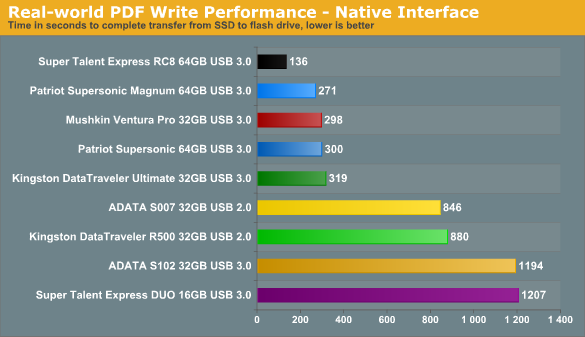
The Super Talent RC8 absolutely screams writing small, compressible files. I contacted both ADATA and Super Talent regarding the poor performance of the S102 and Express DUO, respectively, for this particular test. ADATA acknowledged the garbage collection algorithms of their S102 controller result in noticeable performance degradation during sustained writes of small files. They reported they'll be implementing new controllers in their S102 line of USB 3.0 flash drives.
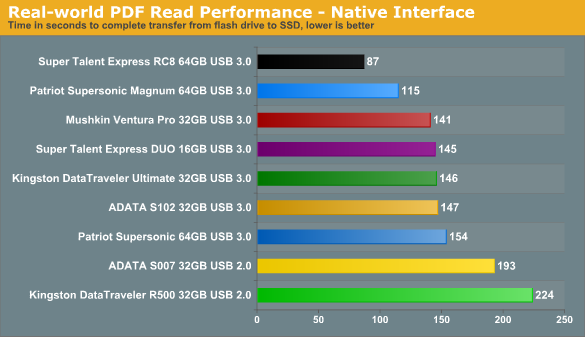
The Super Talent RC8's lead is diminished but still present. If you frequently move lots of smaller files like PDFs and office documents, the RC8's the drive for you.
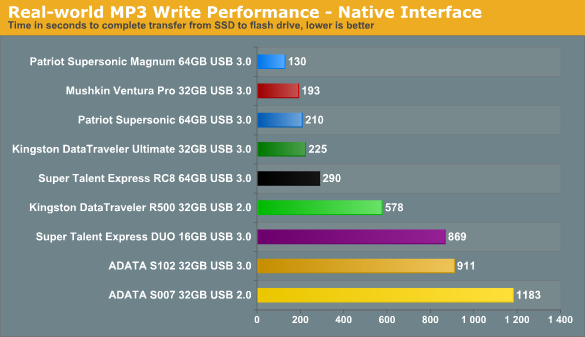
Patriot's Supersonic Magnum takes first place in sustained MP3 writes. The issue with the controllers of the ADATA S102 and Super Talent Express DUO continue to retard their sustained write performance of approximately 5MB file size MP3s. Also notice the Kingston R500 handily bests its USB 2.0 competitor from ADATA.
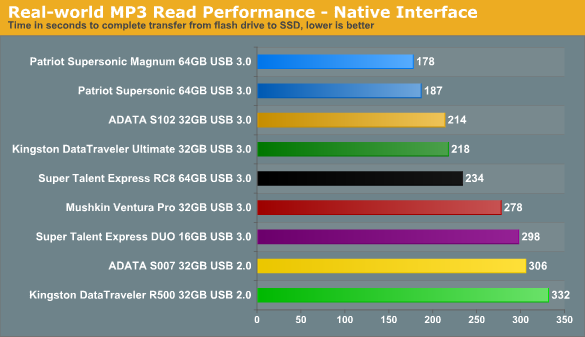
The Supersonic Magnum again produces the fastest MP3 transfer rates. If you're a mobile DJ, that's your drive!
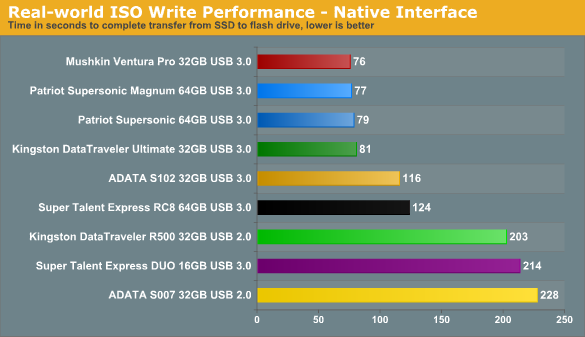
Unsurprisingly, the four drives with the highest 100MB sequential write benchmarks in Iometer perform the best writing a single 4.2GB ISO file.
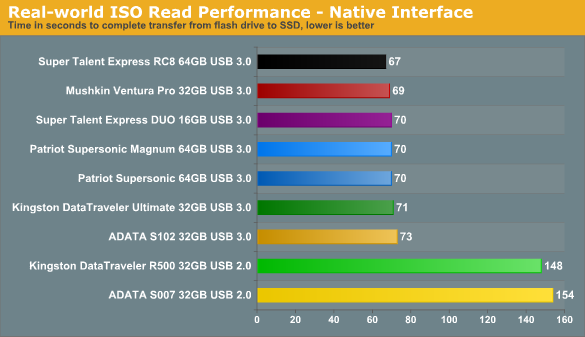
There's less than a 10% separation between the seven USB 3.0 flash drives for sustained single large file read. This chart vividly illustrates how much faster USB 3.0 can potentially be compared to USB 2.0, with the USB 3.0 drives performing more than 100% faster than their USB 2.0 counterparts. Note that we're nowhere near the theoretical transfer rate of USB 3.0 either, so future drives (and controllers) will likely be even faster.
These charts elucidate how superior Iometer synthetic benchmark performance of USB 3.0 flash drives translate into superior real-world performance. Super Talent's Express RC8 is particularly impressive in its ability to write many small, compressible files like PDFs and office documents. Writing many sub-1MB files is a pointed weakness of all flash drives, so the RC8's controller technology is aimed squarely at a glaring issue. And it hits it dead center!
The controller issue that afflicts the ADATA S102 and Super Talent Express DUO USB 3.0 flash drives during sustained smaller (i.e. <10MB) file sizes is a deal-breaker for me given my usage patterns. However, it's important to note that the performance degradation only occurs when transferring many files (the PDF and MP3 tests here each transfer thousands of files). This performance degradation does not occur when transferring a handful of files. You might or might not run afoul of their Achilles' Heel.
The question remains whether USB 3.0 flash drives outperform USB 2.0 devices when both are utilizing a USB 2.0 interface. Find out on the next page!










42 Comments
View All Comments
webmastir - Friday, July 29, 2011 - link
great write up, thanks!Kelemvor - Friday, July 29, 2011 - link
Absolutely. Hit on all the topics. Thanks. And they really aren't all that much more expensive.sbrown23 - Friday, July 29, 2011 - link
It was good, but I would like to have seen a testing of Linux distro running from the flash drive to get an idea of performance in that type of scenario. Load each up with a Linux distribution, boot each one and run a couple of benchmarks (heck even include boottime, etc.)pvdw - Thursday, December 1, 2011 - link
Definitely. The biggest use I get out of flash drives is for tech support, so I find random reads and writes sorely lacking. :(xygot - Friday, July 29, 2011 - link
This is a nice article for USB 3.0 using flash drive. However, I'm more interested in benchmark between USB 3.0 and eSata using external hard drive. Is there a benchmark on the way?This is what holding me for now if I need to upgrade to USB 3.0 or stay on eSata.
Zenthar - Friday, July 29, 2011 - link
I would like to see that as well. Given the $/GB of those thumbdrives, I would also be curious to see external USB 3.0 SSDs. Different needs will warrant different solutions.For backups for example (mostly sequential read/write), it would probably be more cost/efficient to get an external 2.5 HDD. If you want something to install and run applications from, then perhaps you will get better performance out of an external SSD.
The extra size of external HDD/SSD could be a bit annoying, but this usually translates to lower possibility of losing or washing the drive.
Gigantopithecus - Friday, July 29, 2011 - link
Hi xygot - I don't plan on adding a USB 3.0 vs eSATA performance comparison to the article. However, I can report that using a USB 3.0 HDD dock with a Western Digital WD20EARS on both ends of the transfer, for MP3 files, I get sustained writes of ~30MB/s and sustained reads of 50MB/s. Hope that helps!ckryan - Friday, July 29, 2011 - link
If you want to use a mechanical HDD, just stick with eSata. You won't be limited in any aspect of the HDD's performance. But I think there are some newer eSata and USB3 docks on the way, or possibly already on the market. Why not both?In my eSata II testing, I've found that a 7200rpm desktop drive has almost identical performance in an enclosure as it does with the Sata ports on the MB. As for USB3.0, I have two motherboards that support it, but no usb 3.0 devices. So I can't really speak to 3.0's performance except to say it's not like your HDD will run faster in a USB3 enclosure than it does in your computer.
As for the few USB3 external HDD, it's always been my preference to roll my own with an enclosure and my own HDD.
Sweeo - Saturday, July 30, 2011 - link
Well for me I would go for USB 3,how many comps/other divices got eSata ?USB 3 backword compatable
The thing is "other devises"
doylecc - Monday, August 1, 2011 - link
Adding eSATA is easy if you have a desktop. The adapter is inexpensive; this one costs less than $5 and provides two eSATA ports:http://www.newegg.com/Product/Product.aspx?Item=N8...
The eSata adapter socket mounts on an expansion card bracket that installs in any unused expansion card opening in the back of your computer.
Performance-wise, eSATA will allow you to extract the full performance from any mechanical hard drive. The faster SSDs need SATA III (6GB/sec) or USB 3 bandwidth for full performance.
Of course, if you have a laptop, you're limited to the built-in ports.